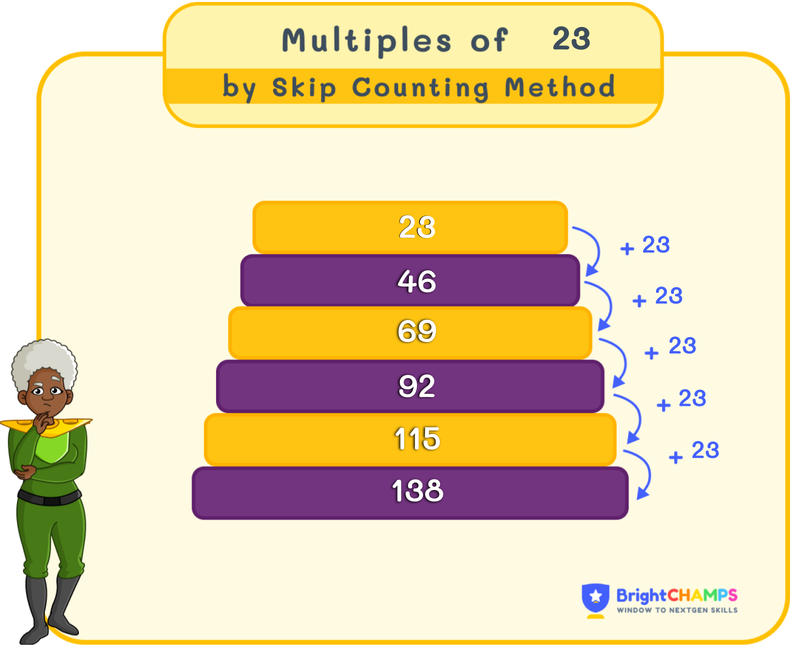
 183 Learners
183 LearnersLast updated on May 26th, 2025

Multiples of 23

In math, multiples are the products we get while multiplying a number with other numbers. Multiples play a key role in construction and design, counting groups of items, sharing resources equally, and managing time effectively. In this topic, we will learn the essential concepts of multiples of 23.
What are the Multiples of 23?
Now, let us learn more about multiples of 23. Multiples of 23 are the numbers you get when you multiply 23 by any whole number, including zero. Each number has an infinite number of multiples, including a multiple of itself. In multiplication, a multiple of 23 can be denoted as 23 × n, where ‘n’ represents any whole number (0, 1, 2, 3,…). So, we can summarize that:
Multiple of a number = Number × Any whole number
For example, multiplying 23 × 1 will give us 23 as the product. Multiples of 23 will be larger or equal to 23.
List of First 20 Multiples of 23
Multiples of 23 include the products of 23 and an integer. Multiples of 23 are divisible by 23 evenly. The first few multiples of 23 are given below:
| TABLE OF 23 (1-10) | |
|---|---|
|
23 x 1 = 23 |
23 x 6 = 138 |
|
23 x 2 = 46 |
23 x 7 = 161 |
|
23 x 3 = 69 |
23 x 8 = 184 |
|
23 x 4 = 92 |
23 x 9 = 207 |
|
23 x 5 = 115 |
23 x 10 = 230 |
| TABLE OF 23 (11-20) | |
|---|---|
|
23 x 11 = 253 |
23 x 16 = 368 |
|
23 x 12 = 276 |
23 x 17 = 391 |
|
23 x 13 = 299 |
23 x 18 = 414 |
|
23 x 14 = 322 |
23 x 19 = 437 |
|
23 x 15 = 345 |
23 x 20 = 460 |
Now, we know the first few multiples of 23. They are 0, 23, 46, 69, 92, 115, 138, 161, 184, 207, 230,...
Operations with Multiples of 23
Understanding the multiples of 23 helps solve mathematical problems and boost our multiplication and division skills. When working with multiples of 23, we need to apply it to different mathematical operations such as addition, subtraction, multiplication, and division.
Sum of first 5 Multiples of 23:
23, 46, 69, 92, and 115 are the first five multiples of 23. When multiplying 23 from 1 to 5, we get these numbers as the products.
So, the sum of these multiples is:
23 + 46 + 69 + 92 + 115 = 345
When we add the first 5 multiples of 23, the answer will be 345.
Subtraction of first 5 Multiples of 23:
While we do subtraction, it improves our comprehension of how the value decreases when each multiple is subtracted from the previous one. So, let us calculate it as given below:
23 - 46 = -23
-23 - 69 = -92
-92 - 92 = -184
-184 - 115 = -299
Hence, the result of subtracting the first 5 multiples of 23 is -299.
Average of first 5 Multiples of 23:
To calculate the average, we need to identify the sum of the first 5 multiples of 23, and then divide it by the count, i.e., 5. Because there are 5 multiples presented in the calculation. Averaging helps us to understand the concepts of central tendencies and other values. We know the sum of the first 5 multiples of 23 is 345.
23 + 46 + 69 + 92 + 115 = 345
Next, divide the sum by 5:
345 ÷ 5 = 69
69 is the average of the first 5 multiples of 23.
Product of First 5 Multiples of 23:
The product of given numbers is the result of multiplying all of them together. Here, the first 5 multiples of 23 include: 23, 46, 69, 92, and 115. Now, the product of these numbers is:
23 × 46 × 69 × 92 × 115 = 331,383,030
The product of the first 5 multiples of 23 is 331,383,030.
Division of First 5 Multiples of 23:
While we perform division, we get to know how many times 23 can fit into each of the given multiples.
23 ÷ 23 = 1
46 ÷ 23 = 2
69 ÷ 23 = 3
92 ÷ 23 = 4
115 ÷ 23 = 5
The results of dividing the first 5 multiples of 23 are: 1, 2, 3, 4, and 5.

Common Mistakes and How to Avoid Them in Multiples of 23
While working with multiples of 23, we make common mistakes. Identifying these errors and understanding how to avoid them can be helpful. Below are some frequent mistakes and tips to avoid them:

Multiples of 23 Examples

Problem 1
Maya is organizing a charity event and decides to distribute gift bags. Each bag contains 23 items, and she plans to distribute them every week. If she continues this pattern for 6 weeks, how many items will she have distributed in total?

138 items
Explanation
Each week, Maya distributes 23 items. To find the total number of items distributed after 6 weeks, multiply the number of items by the number of weeks.
Items distributed each week = 23
Number of weeks = 6
23 × 6 = 138
Therefore, Maya will distribute a total of 138 items in 6 weeks.

Problem 2
In a video game, players earn points in multiples of 23. If three players earn points equivalent to the first three multiples of 23, how many points did each player earn?

The first three multiples of 23 are 23, 46, and 69. The first player earned 23 points, the second earned 46 points, and the third earned 69 points.
Explanation
Identify the first three multiples of 23:
23 × 1 = 23
23 × 2 = 46
23 × 3 = 69
Thus, the first player earned 23 points, the second earned 46 points, and the third earned 69 points.

Problem 3
At a factory, there are 23 machines, and each machine produces 23 parts every day. How many parts are produced in total each day?

529 parts
Explanation
To find the total number of parts produced, multiply the number of machines by the number of parts each machine produces.
Number of machines = 23
Number of parts each machine produces = 23
23 × 23 = 529
Therefore, a total of 529 parts are produced each day.

Problem 4
Lucas has a collection of stamps arranged in 4 albums. Each album contains 23 stamps. How many stamps does Lucas have in total?

92 stamps
Explanation
To find the total number of stamps, multiply the number of albums by the number of stamps in each album.
Number of albums = 4
Number of stamps in each album = 23
4 × 23 = 92
So, Lucas has a total of 92 stamps.

Problem 5
During a science experiment, a group of students measures the growth of plants. The first plant grows by 23 cm, the second by 46 cm, and the third by 69 cm. What is the total growth of all three plants?

138 cm
Explanation
The growth of the first plant is 23 cm, the second is 46 cm, and the third is 69 cm. Add these measurements together:
23 + 46 + 69 = 138
Therefore, the total growth of all three plants is 138 cm.


FAQs on Multiples of 23
1.How do you find the multiples of 23?
2.What is the LCM of 7 and 23?
3.What are the real-life applications of Multiples of 23?
4.Are multiples of 23 finite or infinite?
5.Is there any odd multiples of 23?
6.How can poems help children in Qatar memorize the Multiplication Table and Multiples of 23?
7.Can learning the Multiplication Table influence creativity in solving Multiples of 23 challenges for kids in Qatar?
8.How do language and cultural differences in Qatar affect the way children learn the Multiplication Table and Multiples of 23?
9.What role does brain development play in mastering the Multiplication Table and Multiples of 23 among early learners in Qatar?
Important Glossaries for Multiples of 23
- Multiple: A multiple represents the product of a number that is multiplied by an integer. For example, multiples of 23 include 23, 46, 69, 92, etc.
- Number pattern: This refers to how numbers are listed. It should follow a certain sequence. Multiples of 23 are the numbers that consist of the number pattern of 23.
- Odd number: An odd number refers to any number that cannot be evenly divided by 2. The last digits of odd numbers are 1, 3, 5, 7, or 9. Some multiples of 23 are odd numbers.
- Divisor: It refers to any number by which another number can be divided without leaving any remainder. 1 and 23 are the divisors of 23.
- LCM (Least Common Multiple): It is the smallest common multiple shared by two or more numbers. For instance, the LCM of 7 and 23 is 161.
Explore More multiplication-tables
About BrightChamps in Qatar


Seyed Ali Fathima S
About the Author
Seyed Ali Fathima S a math expert with nearly 5 years of experience as a math teacher. From an engineer to a math teacher, shows her passion for math and teaching. She is a calculator queen, who loves tables and she turns tables to puzzles and songs.
Fun Fact
: She has songs for each table which helps her to remember the tables




